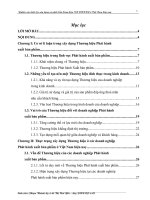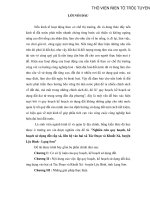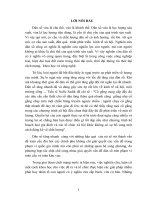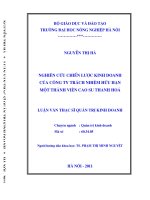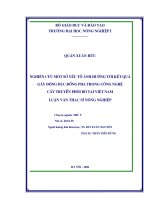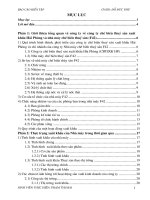NGHIÊN cứu CHIẾN lược bày tỏ sự hài LÒNG được sử DỤNG bởi BAN GIÁM KHẢO TRONG HAI CHƯƠNG TRÌNH TRUYỀN HÌNH THỰC tế THE VOICE u s và THE VOICE VIETNAM
Bạn đang xem bản rút gọn của tài liệu. Xem và tải ngay bản đầy đủ của tài liệu tại đây (538.46 KB, 118 trang )
ABSTRACT
Based on the theoretical background of cross-cultural communication, this study
examines the similarities and differences in satisfaction expressing strategies
between American and Vietnamese judging panels in two reality shows: The Voice
U.S and The Voice Vietnam. It focuses primarily on the popularity and preference of
strategies of expressing satisfaction.
In order to accomplish this thesis paper, quantitative and qualitative methods are
both used in this study with priorities given to the quantitative one. The data were
collected from seven episodes of The Voice U.S season 3 and nine episodes of The
Voice Vietnam season 1 with approximately 2000 minutes in total.
The results gained from the findings and data analysis have revealed eight common
satisfaction expressing strategies employed by American and Vietnamese judging
panels. The analysis of 405 comments using satisfaction expressing strategy (227 in
English and 178 in Vietnamese) showed some significant similarities and
differences between American and Vietnamese judging panels in expressing
satisfaction. It is hopeful that the findings could have partially valuable contribution
to the reduction of culture shocks and pragmatic failures in communication in real
life.
i
TABLE OF CONTENT
Acknowledgements………………………………………………………………… i
Abstract…………………………………………………………………………… ii
List of figures, tables and abbreviations…………………………………………….v
PART A: INTRODUCTION
1. Rationale……………………………………………………………………… 1
2. Aims of the study……………………………………………………………….2
3. Research questions…………………………………………………………… 2
4. Scope of the study………………………………………………………………3
5. Methodology……………………………………………………………………3
6. Significance of the study……………………………………………………… 3
7. Organization of the study……………………………………………………….4
PART B: DEVELOPMENT
CHAPTER 1: LITERATURE REVIEW
1.1 Culture and communication…………………………………………………… 5
1.1.1 Culture……………………………………………………………………….5
1.1.2 Communication………………………………………………………………6
1.1.3 Cross cultural communication……………………………………………….9
1.2 Speech act………………………………………………………………………10
1.2.1 The notion of speech acts………………………………………………… 10
1.2.2 Classification of speech acts……………………………………………… 13
ii
1.2.3 Expressing satisfaction as a speech act…………………………………… 15
1.3 Reality television……………………………………………………………….17
1.3.1 Definition………………………………………………………………… 17
1.3.2 “The Voice” series………………………………………………………….17
1.3.2.1 Definition………………………………………………………………… 17
1.3.2.2 Format description of The Voice U.S season 3 and The Voice Vietnam
season 1…………………………………………………………………… 18
CHAPTER 2: THE STUDY
2.1Methodology……………………………………………………………………20
2.1.1 Material…………………………………………………………………….20
2.1.2 Participants………………………………………………………………….20
2.1.2.1American judging panel (season 3 – 2012)…………………………………20
2.1.2.2 Vietnamese judging panel (season 1 – 2012)………………………………21
2.1.3 Data collection procedure………………………………………………… 21
2.1.4 Data analysis procedure…………………………………………………….21
2.2Results………………………………………………………………………….22
2.2.1 Research question 1……………………………………………………… 22
2.2.2 Research question 2……………………………………………………… 30
2.2.3 Concluding remarks about major cross cultural similarities and
differences………………………………………………………………… 37
PART C: CONCLUSION
1. Summary of the findings……………………………………………………….40
iii
2. Implications…………………………………………………………………….41
3. Limitation of the study…………………………………………………………42
4. Suggestions for further study………………………………………………… 42
REFERENCES………………………………………………… 44
APPENDICES…………………………………………………….47
Appendix A: The Voice U.S
Appendix B: The Voice Vietnam
LIST OF TABLES, FIGURES AND ABBREVIATIONS
Table 1-1: The five general functions of speech acts (Yule, 1996, p. 55)
Table 2-1: Use of satisfaction expressing strategies by judging panels in two reality
shows: The Voice U.S and The Voice Vietnam
Table 2-2: Use of strategy 1 by American panel and Vietnamese panel
Table 2-3: Use of strategy 2 by American panel and Vietnamese panel
Table 2-4: Use of strategy 3 by American panel and Vietnamese panel
Table 2-5: Use of strategy 4 by American panel and Vietnamese panel
Table 2-6: Use of strategy 5 by American panel and Vietnamese panel
Table 2-7: Use of strategy 6 by American panel and Vietnamese panel
Table 2-8: Use of strategy 7 by American panel and Vietnamese panel
Table 2-9: Use of strategy 8 by American panel and Vietnamese panel
Table 2-10: Frequency of using strategies to express satisfaction by American and
Vietnamese judging panels
iv
Figure 1-1: Nguyen Quang’s diagram of components of communication (Nguyen
Quang, 2001, p. 9)
Figure 2-1: Use of satisfaction expressing strategies by American panel in The
Voice U.S
Figure 2-2: Use of satisfaction expressing strategies by Vietnamese panel in The
Voice Vietnam
Figure 2-3: Use of satisfaction expressing strategies by judging panels in two reality
shows: The Voice U.S and The Voice Vietnam
TVU: The Voice U.S
TVN: The Voice Vietnam
v
PART A: INTRODUCTION
1. Statement of the problem and rationale for the study
The desired outcome of the language learning process is the ability to be competent
in not only linguistics but also pragmatics. Language teaching in most of advanced
educations is based on the idea that the goal of language acquisition is
communicative competence. As Hymes (1966) puts it, “speakers of a language
have to have more than grammatical competence in order to be able to
communicate effectively in a language; they also need to know how language is
used by members of a speech community to accomplish their purposes.” (p.20)
Language and culture are intimately related. Language and its structure are entirely
dependent on the cultural context in which they existed. Littlejohn & Foss (2005)
recall that Hymes suggests that “cultures communicate in different ways, but all
forms of communication require a shared code, communicators who know and use
the code, a channel, a setting, a message form, a topic, and an event created by
transmission of the message" (p. 312). Speech communities create and establish
their own speaking codes/norms. Philipsen (1975) explains that “Each community
has its own cultural values about speaking and these are linked to judgments of
situational appropriateness” (p. 13). Learners merely master a language when they
can thoroughly comprehend the interrelationship between language and culture. In
particular, to be able to use the target language appropriately in terms of pragmatic
competence, language learners need to understand how to employ a variety of
speech acts in different contexts of the target culture. Expressing satisfaction is one
of them.
Different speech act strategies reflect culture’s distinctive interactional style. This
characteristic explains why when the conversation is joined by people not coming
from the same culture, breakdowns in communication may happen. Speech acts,
therefore, vary according to the culture it belongs to. Expressing satisfaction is
commonly considered one of the most frequently used speech act in both formal
1
and informal talks. Through investigating the way people apply it in different
culture; we could identify which one is valued in each community.
With all the reasons mentioned above, the researcher is stimulated to conduct a
cross cultural study on satisfaction expressing by judging panels in two reality
show: The Voice U.S and The Voice Vietnam. These two reality shows attracted a
larger number of audience each season in both countries since the preliminary day it
was on air. Within limitation of this study, the researcher would deeply investigate
the situations in which the judging panels express their satisfaction for the
contestants to find out the major similarities as well as the differences between the
two languages. It is hopeful that the findings could have valuable contribution to the
reduction of culture shocks and pragmatic failures in communication in real life.
2. Aims of the study
The study is carried out to accomplish three primary objectives. Firstly, it is
conducted to discover the common strategies to express satisfaction which were
utilized by judges/ coaches in two reality shows: The Voice U.S season 3 and The
Voice Vietnam season 1. In addition, the paper investigates the similarities as well
as the differences between American and Vietnamese judges/coaches ways of
employing those strategies of commenting. Last but not least, raising American or
Vietnamese people’s awareness of the impacts of culture on these differences is also
the main objective of this study.
3. Research questions
This paper aims to investigate common strategies employed by the American and
Vietnamese judging panels to verbally express satisfaction to the contestants in The
Voice U.S and The Voice Vietnam. With a view to achieve these above aims, the
researcher seeks the answers to the following research questions:
Research question 1: What are the common strategies employed by the American
and Vietnamese judging panels to verbally express satisfaction to the contestants in
The Voice U.S (TVU) and The Voice Vietnam (TVV)?
2
Research question 2: What are the similarities and differences in the ways American
and Vietnamese judging panels apply these strategies in the reality show?
4. Scope of the study
There are three seasons of The Voice US with 65 episodes and one season of The
Voice Vietnam with 22 episodes in total. However, due to the size and limitation of
a preliminary research, the study would merely focus on the latest season of each
nation which is The Voice U.S season 3 and The Voice Vietnam season 1. Both of
these two seasons premiered in 2012 and ended in 2012 and the early 2013. More
specifically, this study will analyze satisfaction expressing strategies extracted from
seven episodes of The Voice U.S and nine episodes of The Voice Vietnam with
around 2000 minutes in total.
5. Methodology
Quantitative and qualitative methods are both used in this study with priorities
given to the quantitative one. In the other words, all the conclusions and
considerations are based on the analysis of the empirical studies and statistics
processed on Excel, a software program commonly used in mathematical statistics.
Moreover, such methods as descriptive, analytic, comparative and contrastive are
also utilized to describe and analyze, to compare and contrast the database so as to
find out the similarities and differences in expressing satisfaction strategies.
6. Significance of the study
The present study is conducted to provide a more insight view into how judging
panels from different countries express their satisfaction in the two reality shows
namely The Voice U.S and The Voice Vietnam. It is hopeful that other researchers
who share the same interest in this field of linguistics would find the findings of this
paper useful for their further related studies.
Besides, the study is also expected to provide English learners with knowledge of
sociolinguistics aspect of an English speaking country. Thus, it could add more
3
valuable information for those who want to dig deep into second language
acquisition, pragmatics competence and cross cultural communication of Vietnam
and America.
7. Organization of the study
After the introduction, the rest of the paper includes the following parts:
Chapter 1: Literature review – provides the background of the study including the
definition of key concepts and the discussions of related studies.
Chapter 2: The study – describes the procedures to conduct the research, presents,
analyze the results and discusses the findings the researcher obtained according to
the two research questions.
Conclusion summarized the major issues discussed in the paper, provides some
implications and points out the limitations of the research as well as proposes
several suggestions for further studies. Following this part are References and
Appendix.
4
PART B: DEVELOPMENT
CHAPTER 1: LITERATURE REVIEW
1.1 Culture and communication
1.1.1 Culture
The concept of culture has been defined in a wide variety of patterns for a long time
and no single definition of it has achieved consensus in the literature. The
term "culture" appeared first in its current sense in Europe in the 18th and 19th
centuries, to connote a process of cultivation or improvement. Tylor (1874)
describes culture in the following way: "Culture or civilization, taken in its
wide ethnographic sense, is that complex whole which includes knowledge, belief,
art, morals, law, custom, and any other capabilities and habits acquired by man as
a member of society." (p. 1) Although Tylor explains his understanding of culture in
the course of a larger argument about the nature of religion, this could be
considered a general theory of culture. Other anthropologists have generally
presented their various definitions of culture as refinements of Tylor's. Alfred
(1917) identifies culture with the "superorganic," that is, “a domain with ordering
principles and laws that could not be explained by or reduced to biology” (p. 163).
Gerald (1973, p. 75) reviewed various definitions of culture and debates as to their
parsimony and power, and proposed as the most scientifically useful definition that
"culture" be defined "as our generic term for all human nongenetic, or
metabiological, phenomena" . Hofstede (1984) defines culture as “the collective
programming of the mind which distinguishes the members of one group from
another” (p. 51), which is passed from generation to generation, it is changing all
the time because each generation adds something of its own before passing it on. It
is usual that one’s culture is taken for granted and assumed to be correct because it
is the only one, or at least the first, to be learned.
Culture, therefore, is a complex concept. However, due to limitation of the study,
the researcher would focus on the definitions in which the relationship with the
5
course studied was mentioned. Out of the many possible definitions examined, the
following definition guides this study: “Culture is a shared background (for
example, national, ethnic, religious) resulting from a common language and
communication style, customs, beliefs, attitudes and values (Levine and Adelman -
cited in Nguyen Quang’s lecture note). To be more specific, culture is defined as the
shared patterns of behaviors and interactions, cognitive constructs, and affective
understanding that are learned through a process of socialization. These shared
patterns identify the members of a culture group while also distinguishing those of
another.
1.1.2 Communication
There is a saying that: “Bad human communication leaves us less room to grow.”
As we can see, the etymology of the word ‘communication’ comes from the Latin
‘to make common to many’. This has been the main assumption behind a
considerable number of linguistic theories – that in some way in speaking we share
knowledge with each other in a common pool. No matter how brilliant and
invaluable your idea, it is worthless unless you can share it with others. The
importance of speech and words whether through a paper or a voice is a
communication medium to convey directions and provide synchronization. Thanks
to it, things can be expressed, ideas can be shared, and thoughts can be joined.
Without communication, there is no way to express thoughts, ideas and feelings.
From the dawn of human civilization up to present, a lot of scientists have
attempted to reason the definition of it. But, as Gudykunst and Tingtoomey (1988,
p. 27) point out, "no consensus has been achieved when it comes to formulating an
interdisciplinary definition which can be accepted across the diverse fields of
study." Linguists, considered communication in term of distinct feature, also tried to
give their own ones.
Berko (1989) expresses his view by paying attention to human communication. He
defines:
“The process of communication is a conscious or unconscious, intentional or
unintentional one in which feelings and ideas are expressed in verbal and
6
nonverbal messages. It occurs in intrapersonal, interpersonal, and public levels.
Human communication is dynamic, continuous, irreversible, interactive and
contextual.”
It could be inferred that communication may be intentional or unintentional, may
involve conventional or unconventional signals, may take linguistic or nonlinguistic
forms, and may occur through spoken or other modes. Communication, in general,
is a process by which we assign and convey meaning in an attempt to create shared
understanding.
Another succinct definition offered by Hybels and Weaver (2001, p. 5) is
that communication is “any process in which people share information, ideas, and
feelings that involve not only the spoken and written words but also body language,
personal mannerism and style, the surrounding and things that add meaning to a
message.” In other words, communication is the activity of
conveying information through the exchange of thoughts, messages, or information,
as by speech, visuals, signals, writing, or behavior. Besides, this viewpoint also
mentioned an important aspect of communication related to the means of
transferring messages. In broader expression, there is a variety of verbal and non-
verbal means of communicating exists such as body language, eye contact, sign
language, haptic communication, chronemics, and media such as pictures, graphics,
sound, and writing.
Generally, communication can be viewed as “the process of sharing meaning
through verbal and nonverbal behavior” (Levine and Adelman,1993).To attain a
closer look at communication and its system, the diagram designed by Nguyen
Quang as given below may serve the purpose:
7
Figure 1-1: Nguyen Quang’s diagram of components of communication (Nguyen
Quang, 2001, p. 9)
8
Communication
Verbal communication Nonverbal communication
Intralanguage Paralanguage Extralanguage
- Vocabulary
- Grammatical rules
- Phonetic rules
- Rules of language
- Vocal characteristics:
pitch, volume, rate, vocal
quality, types of vocal
flow.
- Vocal inferences
Body language
(Action language,
kinesics)
Object language
(Artifacts)
Environmental
language
- Eye contact
- Facial expressions
- Gestures
- Postures
- Physical characteristics
- Body movement
- Clothing
- Jewelry
- Make-up
- Artificial scents
- Flowers
- Setting
- Conversational
distance/ proxemics
- Time/ chronemics
- Lighting system
In a nutshell, Peters (2010, p. 7) emphasizes that: “Communication is everyone’s
panacea for everything.” Although several different opinions of how to form the
definition of communication still exists, linguists also reaches the consensus that
communication is not the essence of being human, but also a vital property of life.
Especially in these centuries of information revolution and formation of knowledge
societies, the importance of communication has increased manifold.
1.1.3 Cross cultural communication
As a consequence, the critical identification of the two terms “culture” and
“communication” sheds light on another issue of the correlation between them.
With the process of globalization, especially the increas of global trade, it is
unavoidable that different cultures will meet, conflict, and blend together. People
from different cultures find it hard to communicate not only due to language barrier
but also because of different communication styles. That is the reason why the term
“cross-cultural communication” exists in our life.
According to Kramsch (1998, p. 81), the term “cross-cultural communication” can
be defined as: “the meeting of two cultures or two languages across the political
boundaries of nation-states.” Longman Dictionary of Language Teaching and
Applied Linguistics also shares the same view when considering cross-cultural
communication as: “an exchange of ideas, information, etc. between people from
different background.” In addition, Levine and Adelman (1993) imply that: “cross-
cultural communication is communication (verbal and non-verbal) between people
from different cultures; communication that is influenced by cultural values,
attitudes and behavior; the influence of culture on people’s reactions and responses
to each other.” (p. 94)
To be more specific, the phrase cross-cultural communication describes the ability
to successfully form, foster, and improve relationships with members of a culture
different from one's own. It is based on knowledge of many factors, such as the
other culture's values, perceptions, manners, social structure, and decision-making
practices, and an understanding of how members of the group communicate
9
verbally or non-verbally. Undoubtedly, it is evident that culture differences
significantly contribute to one of the biggest challenge for cross-cultural
communication. Effective communication with people of different cultures is
especially challenging. Cultures provide people with ways of thinking, seeing,
hearing, and interpreting the world. Thus the same words can mean different things
to people from different cultures, even when they talk the "same" language. When
the languages are distinct, translation has to be used to communicate and the
potential for misunderstandings increases, the study of cross-cultural
communication becomes more and more essential.
It is undeniable that cross cultural communication gives opportunities to share
ideas, experiences, and different perspectives and perception by interacting with
local people. However, in order to keep the communication smooth and easy,
people need to be aware of potential problems that may happen during the
communication cycle. If the people involved are not well equipped with the
knowledge of other cultures and a receptive attitude towards cultural divergences,
they are even more likely to fall victim to them.
1.2 Speech act
First mentioned by the Oxford philosopher J.L.Austin in the 1930s and then
subsequently developed in Austin’s pivotal work in the field of linguistics How to
do things with words (1962), “Speech act” has become a key concept and “remain a
central concern of pragmatics, especially cross-cultural pragmatics” (Blum-Kulla
and Kasper, 1989, p. 2). According to Austin, “in saying something the speaker
does something” (1962), which means that words in themselves actions.
1.2.1 The notion of speech acts
The foundation of speech act theory, as mentioned above, was laid by John L.
Austin, and this idea was further elaborated and widely refined across different
disciplines, including both linguistics (especially in pragmatics) and philosophy (i.e.
philosophy of language) by lots of researchers such as Hyme (1964), Searle (1969),
10
Leech (1983), Richards and Schmidt (1983), Levinson (1983), Green (1989) and
Yule (1996). Basic concept of speech act theory is that saying is a part of doing or
words are connected to actions. It could be easily observed from people’s daily
utterance that human communication employs language in various ways. By verbal
communication, they normally act/react or do something as a consequence of
utterances by their interlocutor. In other words, one utterance can trigger a certain
action. For instance, the utterance ‘It is so hot in here!’ uttered immediately after
entering a room with a window wide open in the middle of summer. It can be a
simple statement concerning the high temperature in the room, but it also might be a
request from a speaker to a hearer to close the window and turn on the air
conditioner.
The theory of speech acts aims to do justice to the fact that even though words
(phrases, sentences) encode information, people do more things with words than
convey information and when people convey information, they often convey more
than their words encode. Although the focus of speech act theory has been on
utterances, especially those made in conversational and other face-to-face
situations, the phrase 'speech act' should be taken as a generic term for any sort of
language use, oral or otherwise. Austin (cited from Levinson, 1983) identifies three
distinct levels of action beyond the act of utterance itself. He distinguishes the
act of saying something, what one does in saying it, and what one does by saying it,
and dubs these the 'locutionary', the 'illocutionary' and the 'perlocutionary' act,
respectively. This division is specifically expressed as follow:
First, there is the locutionary act meaning "the act of 'saying' something." A
locutionary act has meaning; it produces an understandable utterance.
Example: (1) The competition will be challenging.
The locutionary act performed in uttering a declarative sentence can be thought of
as the act of stating, placing the proposition in question in the common ground of
some discourse.
Second, there is the illocutionary act aiming "the performance of an act in saying
something as opposed to the performance of an act of saying something." An
11
illocutionary act has force; it is informed with a certain tone, attitude, feeling,
motive, or intention.
Example: By uttering (1), the speaker may be performing the act of informing,
claiming, guessing, reminding, warning, threatening, or requesting. We also say that
utterances are associated with illocutionary forces. In some cases, speakers can
make what illocutionary act they intend to perform explicit.
(2) a. The competition will be challenging. That is a threat.
b. The competition will be challenging. I guess.
c. The competition will be challenging. I am warning you.
d. The competition will be challenging. Let me remind you.
Third, there is the perlocutionary act, for "saying something will often, or even
normally, produce certain consequential effects upon the feelings, thoughts, or
actions of the audience, of the speaker, or of other persons." A perlocutionary act
has consequence; it has an effect upon the addressee.
Example: By uttering (1), I may have achieved in convincing you to practice harder
for the competition.
More particular, by describing an imminently dangerous situation (locutionary
component) in a tone that is designed to have the force of a warning (illocutionary
component), the addresser may actually frighten the addressee into moving
(perlocutionary component). These three components, then, are not altogether
separable, for as Austin (cited from Levinson, 1983) points out, "we must consider
the total situation in which the utterance is issued the total speech act if we are
to see the parallel between statements and performative utterances, and how each
can go wrong. Perhaps indeed there is no great distinction between statements and
performative utterances." In contradistinction to structuralism, then, speech act
theory privileges parole over language, arguing that external context the context
of situation is more important in the order of explanation than internal context
the interrelationships among terms within the system of signs.
Of these three dimensions, the illocutionary force is the most discussed.
Illocutionary acts are considered the core of the theory of speech acts. As already
12
suggested above, an illocutionary act is the action performed by the speaker in
producing a given utterance. The illocutionary act is closely connected with
speaker’s intentions, e.g. stating, questioning, promising, requesting, giving
commands, threatening and many others. As Yule (Yule, 1996, p. 48) claims, “the
illocutionary act is thus performed via the communicative force of an utterance
which is also generally known as illocutionary force of the utterance”. Basically,
the illocutionary act indicates how the whole utterance is to be taken in the
conversation.
1.2.2 Classification of speech acts
Austin (1962) classifies speech acts into five classes. These are: (1) Verdictives,
which verdict where one can exercise judgment, such as declare, rank, grade, call
and acquit; (2) Exercitives, which execute of right, authority, and influence such as
order, designate, command, advice and appoint; (3) Commisives, which commit the
speaker to a certain action such as promise, guarantee, intend, pledge, vow, and
swear; (4) Expositives, which clarify the way utterances fit the proceedings of
conversation or arguments such as affirm, describe, accept, or explain; and (5)
Bahabitives, which react towards behaviors of others, such as apologizing,
congratulating, swearing, applauding and thanking.
Unfortunately, Austin’s classifications are often argued as incomplete and those
cannot cover all possible dimensions, in which speech act can vary. One problem is
that the same utterance could potentially have different illocutionary forces.
Therefore, it is hard for the speaker to assume whether the intended illocutionary
force will be recognized by the hearer. For those reason, Searle (1969, p. 12 – 19)
proposes five alternatives of speech act classification.
13
1. Presentatives: The illocutionary act where the speaker describe states or
events, such as reporting, claiming, explaining, classifying, describing,
declaring, affirming, and et cetera
2. Directives: The illocutionary act where the speaker tries to get listeners to do
something, such as requesting, ordering, suggesting, commanding, inviting.
3. Commisisves: The illocutionary act where the speaker stated a commitment.
He commits himself to do something in the future. Such as promising,
threatening, agreeing, refusing, and et cetera.
4. Expressive: The illocutionary act where the speaker expresses his feeling and
attitude, such as complimenting, thanking, apologizing, greeting, welcoming,
etc.
5. Declaratives: The illocutionary act where the speaker brings out a change in
the world. Such as firing, marrying, divorcing, and et cetera.
Mey (2001, p. 87) points that Searle’s proposal “is more oriented than Austin’s
towards the real world, in as much as it takes its point of departure in what actually
in the case, namely that people perform a speech act whenever they use language,
irrespective of the “performative” criterion,” yet noted that these ways of
classification still share similarities. Following Searle, Yule (1996) summarizes the
five general functions of speech acts with their key features as below:
14
Table 1-1: The five general functions of speech acts (Yule, 1996, p. 55)
Speech act type Direction of fit S = speaker; X = situation
Declaration
Representatives
Expressives
Directives
Commissives
Words change the world
Make words fit the world
Make words fit the world
Make the world fit words
Make the world fit words
S causes X
S believes X
S feels X
S wants X
S intends X
There is no doubt that these above ways of classification are the most influential
and logical ones ever proposed. However, sometimes it is not easy to determine
what kind of illocutionary act the speaker performs. Another important thing, which
should not be forgotten while encoding or decoding speech acts, is that certain
speech acts can be culture-specific and that is why they cannot be employed
universally. In order to correctly decode the illocutionary act performed by the
speaker, it is also necessary for the hearer to be acquainted with the context the
speech act occurs in. Mey (2001, p. 139) says that one should not believe a speech
act to be taking place, before one has considered, or possibly created, the
appropriate context. In addition, a lot of linguists also mentioned that speech act
was constrained by politeness principle at different degrees depending on different
cultures.
1.2.3 Expressing satisfaction as a speech act
As found in Oxford Advanced leaner’s dictionary, satisfaction is “the good feeling
that you have when you have achieved something or when something that you
wanted to happen does happen; something that gives you this feeling”. Similarly,
Longman dictionary of contemporary English for advanced learner defines that
satisfaction is “a feeling of happiness or pleasure because you have achieved
something or got what you wanted”.
15
In accordance with the classification model of Speech act from Searle (1969, p.
240) and Yule (1996, p. 55), “expressing satisfaction” belongs to type “expressive”
– “the illocutionary act where the speaker expresses his feeling and attitude”. For
example:
Wow, very good job!
Spectacular!
In addition, “expressing satisfaction” can be categorized as “representative” – “the
illocutionary act where the speaker describes state or event”. For instance:
I think every song you take; you make it your own.
You changed the song enough to put your mark on it.
Moreover, “expressing satisfaction” could be also classified as “directives” – “the
illocutionary act where the speaker tries to get listener to do something” as follows
If you‘re going to make records, you should make.
Finally, “expressing satisfaction” can be considered as “commissives” – “the
illocutionary act where the speaker states a commitment” such as:
I will vote for you tonight, definitely, I promise.
In short, lying on such basis, “expressing satisfaction” is a kind of speech act which
belongs to four out of five types mentioned in the classification model proposed by
Searle (1969, p. 240) and Yule (1996, p. 55). Specifically, to grasp it briefly, in term
of verbal strategies, there are eight ways to identify “satisfaction”:
Strategy 1: Complimenting
Strategy 2: Exaggerating
Strategy 3: Predicting bright prospect
Strategy 4: Suggesting things to do
Strategy 5: Using jokes
Strategy 6: Offering help or reward
Strategy 7: Showing understanding and sympathy
Strategy 8: Showing admiration
The closer look into this aspect of linguistic field would be shed light on in the next
chapter.
16
1.3 Reality television
1.3.1 Definition
Reality television saw an explosion of global popularity starting in the summer of
2000.
As defined by Hill (2005), reality television is “a television
programming genre that presents purportedly unscripted melodramatic or
humorous situations, documents actual events, and usually features ordinary people
instead of professional actors, sometimes in a contest or other situation where a
prize is awarded.”
Similarly, according to Collins Cobuild Advanced Learner’s English Dictionary, “a
reality show is a type of television programming that aims to show how ordinary
people behave in everyday life, or in situations, often created by programme
makers, which are intended to present everyday life.”
Another sub-genre of reality TV is "reality competition" or so-called "reality game
shows," which follows the format of non-tournament elimination contests.
Typically, participants are filmed competing to win a prize, often while living
together in a confined environment. Participants are usually removed from a team
until there is only one person who is then declared the winner. Usually this is done
by eliminating participants one at a time, in balloon debate style, through
either disapproval voting or by voting for the most popular choice to win. Voting is
done by the viewing audience, the show's own participants, a panel of judges, or
some combination of the three. One of the most noticing reality competitions will
be introduced in the next section.
1.3.2 “The Voice” series
1.3.2.1 Definition
The Voice is a hit reality vocal competition series that searches for the nation's best
voice breaking audience records in multiple territories worldwide. Lauched as “The
17
Voice of Holland” in the Netherlands in 2010, the format has since become one of
the most successful and progressively growing entertainment brands in the world.
Many other countries have adapted the format and began airing their national
versions in 2011 and 2012. The format is a popular one and has often been
redesigned for television in the United States and Vietnam as well. The series was
created and licensed internationally by Dutch-based Talpa Media Group. The
franchise has signed a global recording and artist services agreement with Universal
Music Group.
1.3.2.2 Format description of The Voice U.S season 3 (2012) and the Voice
Vietnam season 1 (2012)
There are three phases in the series: a blind audition (“vòng giấu mặt” or the
"unseen" audition in the U.S which was recently changed due to a proposed lawsuit
from the American Legion of Blind persons), a battle phase (“vòng đối đầu”), and
live performance shows. Four judges/coaches, all particularly noteworthy recording
artists, choose teams of contestants through a blind audition process. The coaches
hear the artists perform (about sixty seconds to ninety seconds), but they don't get to
see them thanks to rotating chairs. If a coach is impressed by the artist’s voice,
he/she pushes a button to select the artist for his/her team. At this point, the coach’s
chair will swivel so that he/she can face the artist he/she has selected. If two or more
judges want the same singer, the singer has the final choice of coach. If no coach
pushes their button, the artist is eliminated from the competition.
Each team of singers is mentored and developed by its respective coach. Coaches
will dedicate themselves to developing their team of artists, giving them advice, and
sharing the secrets of their success along with the help from their celebrity
advisers. In the second stage, called the battle phase, coaches have two of their team
members battle against each other directly by singing the same song together, with
the coach choosing which team member to advance from each of individual
"battles" into the first live round. Within that first live round, the surviving acts
from each team again compete head-to-head, with public votes determining one of
18
two acts from each team that will advance to the final six, while the coach chooses
which of the remaining three acts comprises the other performer remaining on the
team.
In the final live performance phase of the competition, the top artists from each
team will compete each week against each other during a live broadcast. The
coaches have the power to save one contestant that had not received the public's
vote that week. As of season two in the U.S and season one in Vietnam, these
contestants would give a last chance performance to win their coach's save.
However, in deciding who moves on to the final four phases, the television
audience and the coaches have equal say 50/50. With one team member remaining
for each coach, the contestants compete against each other in the finale where the
outcome is decided solely by public vote. It is also noted that in “The Voice” season
3 in the U.S, for the first time in the series, coaches will not be guaranteed a spot to
the finals. This is the first season to feature three performers in the finale instead of
four.
19
CHAPTER 2: THE STUDY
This chapter presents the details of the methodology employed to answer the
research questions including the material, participants, data collection procedures
and data analysis procedures. Quantitative and qualitative methods are both used in
this study with priorities given to the quantitative one.
2.1Methodology
2.1.1 Material
The American and Vietnamese reality shows “The Voice U.S” season 3 -2012 and
“The Voice Vietnam” season 1 – 2012 is used for analysis in this study.
2.1.2 Participants
2.1.2.1 American judging panel (season 3 – 2012)
Judges/ Coaches Personal information
1 Christina María Aguilera
(born December 18, 1980)
An American singer, songwriter, performer,
producer, director and actress.
2 Thomas DeCarlo
Callaway better known by
his stage name Cee Lo
Green
(born May 30, 1974)
An American singer-songwriter-producer,
television personality, actor, entrepreneur, pop
culture and fashion icon.
3 Adam Noah Levine
(born March 18, 1979)
An American singer-songwriter, musician and
occasional actor
best known as the front man
and lead singer of American pop
rock band Maroon 5.
4 Blake Tollison
Shelton (born June 18,
An American country music artist and
television personality.
20
